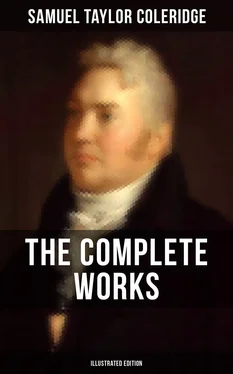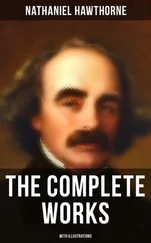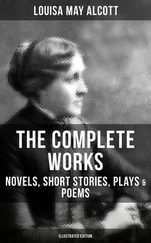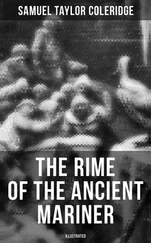With respectful compliments to Mrs. Gillman and her sister, I remain, dear sir,
Your much obliged,
S.T. COLERIDGE.”
On the evening appointed, Coleridge came, bringing in his hand the proof sheets of ‘Christabel’, which was now for the first time printed. The fragment in manuscript was already known to many, for to many had Coleridge read it, who had listened to it with delight — a delight so marked that its success seemed certain. But the approbation of those whom, in the worldly acceptation of the term, we call ‘friends’, is not always to be relied upon. Among the most plausible connexions, there is often a rivalship, both political and literary, which constrains the sacrifice of sincerity, and substitutes secret for open censure. Of this melancholy fact Coleridge had seen proof. The Fragment had not long been published before he was informed, that an individual had been selected (who was in truth a great admirer of his writings; and whose very life had been saved through the exertions of Coleridge and Mr. Southey,) to “‘cut up’” Christabel in the Edinburgh Review. The subject being afterwards mentioned in conversation, the reviewer confessed that he was the writer of the article, but observed, that as he wrote for the Edinburgh Review, he was compelled to write in accordance with the character and tone of that periodical. This confession took place after he had been extolling the Christabel as the finest poem of its kind in the language, and ridiculing the public for their want of taste and discrimination in not admiring it. — Truly has it been said,
”Critics upon all writers there are many,
Planters of truth or knowledge scarcely any.”
Sir Walter Scott always spoke in high praise of the Christabel, and more than once of his obligations to Coleridge; of this we have proof in his Ivanhoe, in which the lines by Coleridge, entitled “The Knight’s Tomb,” were quoted by Scott before they were published, from which circumstance, Coleridge was convinced that Sir Walter was the author of the Waverly Novels. The lines were composed as an experiment for a metre, and repeated by him to a mutual friend — this gentleman the following day dined in company with Sir Walter Scott, and spoke of his visit to Highgate, repeating Coleridge’s lines to Scott, and observing at the same time, that they might be acceptable to the author of Waverley.
THE KNIGHT’S TOMB.
Where is the grave of Sir Arthur O’Kellyn?
Where may the grave of that good man be? —
By the side of a spring, on the breast of Helvellyn,
Under the twigs of a young birch tree!
The Oak that in summer was sweet to hear,
And rustled its leaves in the fall of the year;
And whistled and roar’d in the winter alone,
Is gone, — and the birch in its stead is grown. —
The Knight’s bones are dust,
And his good sword rust; —
His soul is with the saints, I trust.
‘Poetical Works’, Vol. ii. p. 64.
The late Mr. Sotheby informed me, that, at his house in a large party,
Sir Walter made the following remark:
“I am indebted to Coleridge for the mode of telling a tale by question and answer. This was a new light to me, and I was greatly struck by it.”
Yet when Sir Walter said this, he must surely have forgotten many of our ancient and most beautiful ballads, in which the questions are so significant, and are made to develope the progress of the fable more clearly than could be affected by the ordinary course of narration. In fact every lover of our old poetry will recollect a hundred pieces in which the same form of evolution is observed. Thus in ‘Johnie of Breadis Lee’:
”What news, what news, ye grey-headed carle,
What news bring ye to me?”
And in ‘Halbert the Grim’:
”There is pity in many, —
Is there any in him?
No! ruth is a strange guest
To Halbert the Grim.”
Scott particularly admired Coleridge’s management of the supernatural. The “flesh and blood reality,” given to Geraldine, the life, the power of appearing and disappearing equally by day as by night, constitutes the peculiar merit of the Christabel: and those poets who admire, and have reflected much on the supernatural, have ever considered it one of the greatest efforts of genius. But the effect has ever been degraded by unnatural combinations. Thus on the stage, where such creations are the most frequent, it has been the custom for stage-managers to choose ‘male’ actors for the female parts. In ‘Macbeth’, men are called on to stir the caldron and other witcheries requiring muscular power. Again, when Macbeth listens to those extraordinary beings, who, with muttering spells, with charms, foreknowledge and incantations imperfectly announced to him his fate; he, with an air of command, says, “Speak!” &c. They shew their power, and give their best answer by disappearing. The manner of representing this is unnatural, as exhibited by our managers. Coleridge observed, that it would be better to withdraw the light from the stage, than to exhibit these miserable attempts at vanishing, though could the thought have been well executed, he considered it a master-stroke of Shakspeare’s. Yet it should be noticed, that Coleridge’s opinion was, that some of the plays of our “myriad-minded” bard ought never to be acted, but looked on as poems to be read, and contemplated; and so fully was he impressed with this feeling, that in his gayer moments he would often say, “There should be an Act of Parliament to prohibit their representation.” Here ‘he’ excelled: he has no incongruities, no gross illusions. In the management of the supernatural, the only successful poets among our own countrymen have been Shakspeare and Coleridge. Scott has treated it well in the Bride of Lammermoor, and in one or two other works.
Of the Christabel, as now published, Coleridge says, “The first part was composed in 1797.” This was the Annus Mirabilis of this great man; in it he was in his best and strongest health. He returned from Germany in 1799, and in the year following wrote the ‘second’ part, in the preface to which he observes, “Till very lately my poetic powers have been in a state of suspended animation.” The subject indeed remained present to his mind, though from bad health and other causes, it was left as a mere fragment of his poetic power. When in health he sometimes said, “This poem comes upon me with all the loveliness of a vision;” and he declared, that though contrary to the advice of his friends, he should finish it: At other times when his bodily powers failed him, he would then say, “I am reserved for other works than making verse.”
In the preface to the Christabel, he makes the following observation:
“It is probable,” he says, “that if the poem had been finished at either of the former periods, ‘i.e’. 1797 and 1800, or if even the first and second part of this fragment had been published in the year 1800, the impression of its originality would have been much greater than I dare at present expect. But for this, I have only my own indolence to blame. The dates are mentioned for the exclusive purpose of precluding charges of plagiarism or servile imitation from myself. For there is among us a set of critics who seem to hold, that every possible thought and image is traditional; who have no notion that there are such things as fountains in the world, small as well as great; and who would therefore charitably derive every rill, they behold flowing, from a perforation made in some other man’s tank. I am confident, however, that as far as the present poem is concerned, the celebrated poets whose writings I might be suspected of having imitated, either in particular passages, or in the tone and the spirit of the whole, would be among the first to vindicate me from the charge, and who, on any striking coincidence, would permit me to address them in this dogged version of two monkish Latin hexameters:
Читать дальше












